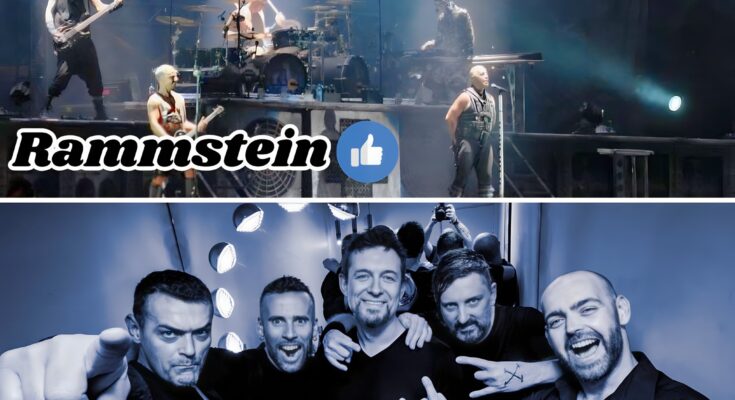Rammstein’s industrial metal is grandiose, dramatic, and driven by powerful rhythms, while Pitchshifter blends industrial, electronic, and nu-metal elements with bold, experimental flair.
Rammstein and Pitchshifter occupy two distinct yet overlapping realms of heavy music, each carving a unique path through the industrial landscape. Rammstein’s industrial metal is grandiose, dramatic, and driven by powerful rhythms, while Pitchshifter blends industrial, electronic, and nu-metal elements with bold, experimental flair. To understand the differences and nuances between these two formidable acts, it is necessary to explore not only their musical characteristics but also their approach to performance, composition, and cultural impact. Rammstein, hailing from Germany, emerged in the mid-1990s with a sound that immediately captured attention for its theatrical intensity and precise, pounding rhythms. Their music is constructed with a sense of calculated weight, where each riff, drum strike, and synthesized layer feels deliberate, creating an atmosphere that is both commanding and ominous. The foundation of Rammstein’s sound is rooted in industrial metal, a genre characterized by mechanized textures, repetitive yet hypnotic rhythms, and a relentless energy that borders on the ritualistic. Their guitar riffs are often low-tuned and hammering, designed to evoke a visceral physical response from the listener, while the percussion carries a sense of martial authority, reminiscent of pounding machinery or marching boots. Over this sonic architecture, the vocals of Till Lindemann provide a dramatic and often chilling counterpoint. Lindemann’s baritone delivery is measured, powerful, and theatrical, blending an almost operatic intensity with the harshness of metal. His voice acts as both narrator and instigator, guiding the listener through Rammstein’s darkly poetic visions, which range from social commentary to tales of grotesque absurdity. The band’s use of electronic elements is subtle but significant, adding layers of texture and occasional melodic contrast to the otherwise pounding and aggressive instrumentation. Synthesized sequences and industrial noises do not merely fill space; they interact with the guitars and drums to create a cohesive sonic landscape, one that is simultaneously abrasive and hypnotically compelling. Beyond the studio recordings, Rammstein’s identity is inseparable from their live performances. Their shows are legendary for pyrotechnics, theatrical staging, and dramatic choreography, all of which transform their music into a full sensory experience. The bombastic nature of these performances reinforces the music’s intensity, allowing fans to feel the power of each note as a physical force. The combination of precise musical execution, overwhelming visual spectacle, and darkly poetic lyrical content positions Rammstein as a band that embodies both the aesthetic and the philosophy of industrial metal. In contrast, Pitchshifter emerged from the UK with a different, yet equally compelling, approach to heavy music. Their sound is rooted in industrial and nu-metal traditions, but they incorporate electronic experimentation and an experimental mindset that constantly pushes genre boundaries. Pitchshifter’s music is less about the mechanical precision of Rammstein and more about the fusion of textures, rhythms, and sonic exploration. The guitars often retain the heaviness associated with metal, but they are complemented by electronic sequences, samples, and effects that give the music an experimental edge. Unlike Rammstein’s structured and imposing arrangements, Pitchshifter frequently embraces irregular rhythms, dynamic shifts, and a willingness to challenge listener expectations. This approach reflects a philosophy of innovation, where the boundaries between electronic, industrial, and metal music are fluid and constantly shifting. Vocally, Pitchshifter experiments with distortion, layering, and rhythmic delivery that can range from aggressive screams to manipulated electronic tones. This versatility allows them to navigate multiple emotional landscapes within a single song, from anger and frustration to surreal or dystopian imagery. The electronic and experimental elements are not merely decorative; they are central to the band’s identity, creating a soundscape that is both challenging and immersive. Pitchshifter’s live performances, while less theatrical than Rammstein’s pyrotechnic spectacles, emphasize energy, intensity, and a connection with the audience through sonic experimentation. They often incorporate real-time manipulation of electronic elements, improvisation, and layering that make each performance unique. This willingness to explore uncharted territory gives the band a sense of unpredictability, contrasting with Rammstein’s carefully orchestrated stagecraft. Thematically, both bands engage with dark, provocative subject matter, but their approaches differ. Rammstein tends to dramatize narratives, often using irony, satire, and grotesque imagery to confront social taboos and human psychology. Their lyrics, delivered with Lindemann’s commanding presence, amplify the theatricality of their music and create a layered experience that combines storytelling with sonic intensity. Pitchshifter, on the other hand, leans into political and technological themes, exploring the intersections of society, technology, and identity in a way that complements their experimental sound. Their lyrical content often reflects a critical perspective on modernity, blending urgency with intellectual engagement, and their music reinforces this through complex, layered arrangements that mirror the chaos or tension of the subjects they explore. While both bands are part of the broader industrial and metal milieu, their cultural impact is felt differently. Rammstein has achieved global recognition, in part due to their ability to merge the spectacle of performance with the precision of musical craftsmanship. They have influenced countless bands across metal and industrial genres, and their aesthetic—combining militaristic visuals, pyrotechnics, and dark humor—has become iconic. Pitchshifter’s influence is subtler but no less significant; their experimentation with electronic integration and genre fusion has inspired a generation of artists to challenge traditional definitions of metal and industrial music, encouraging innovation and hybridization across genres. Comparing Rammstein and Pitchshifter highlights the diversity and adaptability of industrial metal as a musical form. Rammstein embodies the grandeur, drama, and disciplined force of the genre, transforming music into a visceral, almost ritualistic experience. Pitchshifter exemplifies the exploratory, boundary-pushing potential of industrial-infused metal, fusing electronics, experimentation, and heavy riffs to create music that is unpredictable, inventive, and intellectually engaging. Both bands demonstrate the power of industrial metal to provoke, challenge, and captivate, but they do so through contrasting philosophies: one through theatrical precision and commanding presence, the other through experimental audacity and sonic curiosity. In essence, Rammstein and Pitchshifter represent two poles of industrial metal’s expressive capacity. The former harnesses the dramatic and ritualistic qualities of sound and performance to create a powerful, almost mythic presence, while the latter leverages electronic innovation and hybridized textures to explore the possibilities of metal beyond conventional structures. Listeners encounter in Rammstein a deliberate, almost cinematic intensity, where every element serves the overarching vision, while Pitchshifter offers an adventurous journey through complex sonic landscapes, constantly defying expectations and encouraging active engagement with the music. Ultimately, the comparison of Rammstein and Pitchshifter underscores the richness of industrial and experimental metal, demonstrating that even within overlapping genres, bands can pursue vastly different artistic paths. Rammstein’s grandiosity and performative dominance create an immersive, unforgettable experience, while Pitchshifter’s experimental fusion challenges, provokes, and expands the boundaries of heavy music. Both bands, in their distinct ways, exemplify the vitality, diversity, and creative potential of industrial metal, offering fans a spectrum of experiences from commanding spectacle to inventive experimentation. Through their music, performances, and cultural contributions, Rammstein and Pitchshifter affirm that industrial metal is not a monolithic genre but a dynamic and evolving art form, capable of both monumental impact and daring innovation.Rammstein’s industrial metal is grandiose, dramatic, and driven by powerful rhythms, while Pitchshifter blends industrial, electronic, and nu-metal elements with bold, experimental flair. To understand the differences and nuances between these two formidable acts, it is necessary to explore not only their musical characteristics but also their approach to performance, composition, and cultural impact. Rammstein, hailing from Germany, emerged in the mid-1990s with a sound that immediately captured attention for its theatrical intensity and precise, pounding rhythms. Their music is constructed with a sense of calculated weight, where each riff, drum strike, and synthesized layer feels deliberate, creating an atmosphere that is both commanding and ominous. The foundation of Rammstein’s sound is rooted in industrial metal, a genre characterized by mechanized textures, repetitive yet hypnotic rhythms, and a relentless energy that borders on the ritualistic. Their guitar riffs are often low-tuned and hammering, designed to evoke a visceral physical response from the listener, while the percussion carries a sense of martial authority, reminiscent of pounding machinery or marching boots. Over this sonic architecture, the vocals of Till Lindemann provide a dramatic and often chilling counterpoint. Lindemann’s baritone delivery is measured, powerful, and theatrical, blending an almost operatic intensity with the harshness of metal. His voice acts as both narrator and instigator, guiding the listener through Rammstein’s darkly poetic visions, which range from social commentary to tales of grotesque absurdity. The band’s use of electronic elements is subtle but significant, adding layers of texture and occasional melodic contrast to the otherwise pounding and aggressive instrumentation. Synthesized sequences and industrial noises do not merely fill space; they interact with the guitars and drums to create a cohesive sonic landscape, one that is simultaneously abrasive and hypnotically compelling. Beyond the studio recordings, Rammstein’s identity is inseparable from their live performances. Their shows are legendary for pyrotechnics, theatrical staging, and dramatic choreography, all of which transform their music into a full sensory experience. The bombastic nature of these performances reinforces the music’s intensity, allowing fans to feel the power of each note as a physical force. The combination of precise musical execution, overwhelming visual spectacle, and darkly poetic lyrical content positions Rammstein as a band that embodies both the aesthetic and the philosophy of industrial metal. In contrast, Pitchshifter emerged from the UK with a different, yet equally compelling, approach to heavy music. Their sound is rooted in industrial and nu-metal traditions, but they incorporate electronic experimentation and an experimental mindset that constantly pushes genre boundaries. Pitchshifter’s music is less about the mechanical precision of Rammstein and more about the fusion of textures, rhythms, and sonic exploration. The guitars often retain the heaviness associated with metal, but they are complemented by electronic sequences, samples, and effects that give the music an experimental edge. Unlike Rammstein’s structured and imposing arrangements, Pitchshifter frequently embraces irregular rhythms, dynamic shifts, and a willingness to challenge listener expectations. This approach reflects a philosophy of innovation, where the boundaries between electronic, industrial, and metal music are fluid and constantly shifting. Vocally, Pitchshifter experiments with distortion, layering, and rhythmic delivery that can range from aggressive screams to manipulated electronic tones. This versatility allows them to navigate multiple emotional landscapes within a single song, from anger and frustration to surreal or dystopian imagery. The electronic and experimental elements are not merely decorative; they are central to the band’s identity, creating a soundscape that is both challenging and immersive. Pitchshifter’s live performances, while less theatrical than Rammstein’s pyrotechnic spectacles, emphasize energy, intensity, and a connection with the audience through sonic experimentation. They often incorporate real-time manipulation of electronic elements, improvisation, and layering that make each performance unique. This willingness to explore uncharted territory gives the band a sense of unpredictability, contrasting with Rammstein’s carefully orchestrated stagecraft. Thematically, both bands engage with dark, provocative subject matter, but their approaches differ. Rammstein tends to dramatize narratives, often using irony, satire, and grotesque imagery to confront social taboos and human psychology. Their lyrics, delivered with Lindemann’s commanding presence, amplify the theatricality of their music and create a layered experience that combines storytelling with sonic intensity. Pitchshifter, on the other hand, leans into political and technological themes, exploring the intersections of society, technology, and identity in a way that complements their experimental sound. Their lyrical content often reflects a critical perspective on modernity, blending urgency with intellectual engagement, and their music reinforces this through complex, layered arrangements that mirror the chaos or tension of the subjects they explore. While both bands are part of the broader industrial and metal milieu, their cultural impact is felt differently. Rammstein has achieved global recognition, in part due to their ability to merge the spectacle of performance with the precision of musical craftsmanship. They have influenced countless bands across metal and industrial genres, and their aesthetic—combining militaristic visuals, pyrotechnics, and dark humor—has become iconic. Pitchshifter’s influence is subtler but no less significant; their experimentation with electronic integration and genre fusion has inspired a generation of artists to challenge traditional definitions of metal and industrial music, encouraging innovation and hybridization across genres. Comparing Rammstein and Pitchshifter highlights the diversity and adaptability of industrial metal as a musical form. Rammstein embodies the grandeur, drama, and disciplined force of the genre, transforming music into a visceral, almost ritualistic experience. Pitchshifter exemplifies the exploratory, boundary-pushing potential of industrial-infused metal, fusing electronics, experimentation, and heavy riffs to create music that is unpredictable, inventive, and intellectually engaging. Both bands demonstrate the power of industrial metal to provoke, challenge, and captivate, but they do so through contrasting philosophies: one through theatrical precision and commanding presence, the other through experimental audacity and sonic curiosity. In essence, Rammstein and Pitchshifter represent two poles of industrial metal’s expressive capacity. The former harnesses the dramatic and ritualistic qualities of sound and performance to create a powerful, almost mythic presence, while the latter leverages electronic innovation and hybridized textures to explore the possibilities of metal beyond conventional structures. Listeners encounter in Rammstein a deliberate, almost cinematic intensity, where every element serves the overarching vision, while Pitchshifter offers an adventurous journey through complex sonic landscapes, constantly defying expectations and encouraging active engagement with the music. Ultimately, the comparison of Rammstein and Pitchshifter underscores the richness of industrial and experimental metal, demonstrating that even within overlapping genres, bands can pursue vastly different artistic paths. Rammstein’s grandiosity and performative dominance create an immersive, unforgettable experience, while Pitchshifter’s experimental fusion challenges, provokes, and expands the boundaries of heavy music. Both bands, in their distinct ways, exemplify the vitality, diversity, and creative potential of industrial metal, offering fans a spectrum of experiences from commanding spectacle to inventive experimentation. Through their music, performances, and cultural contributions, Rammstein and Pitchshifter affirm that industrial metal is not a monolithic genre but a dynamic and evolving art form, capable of both monumental impact and daring innovation.



